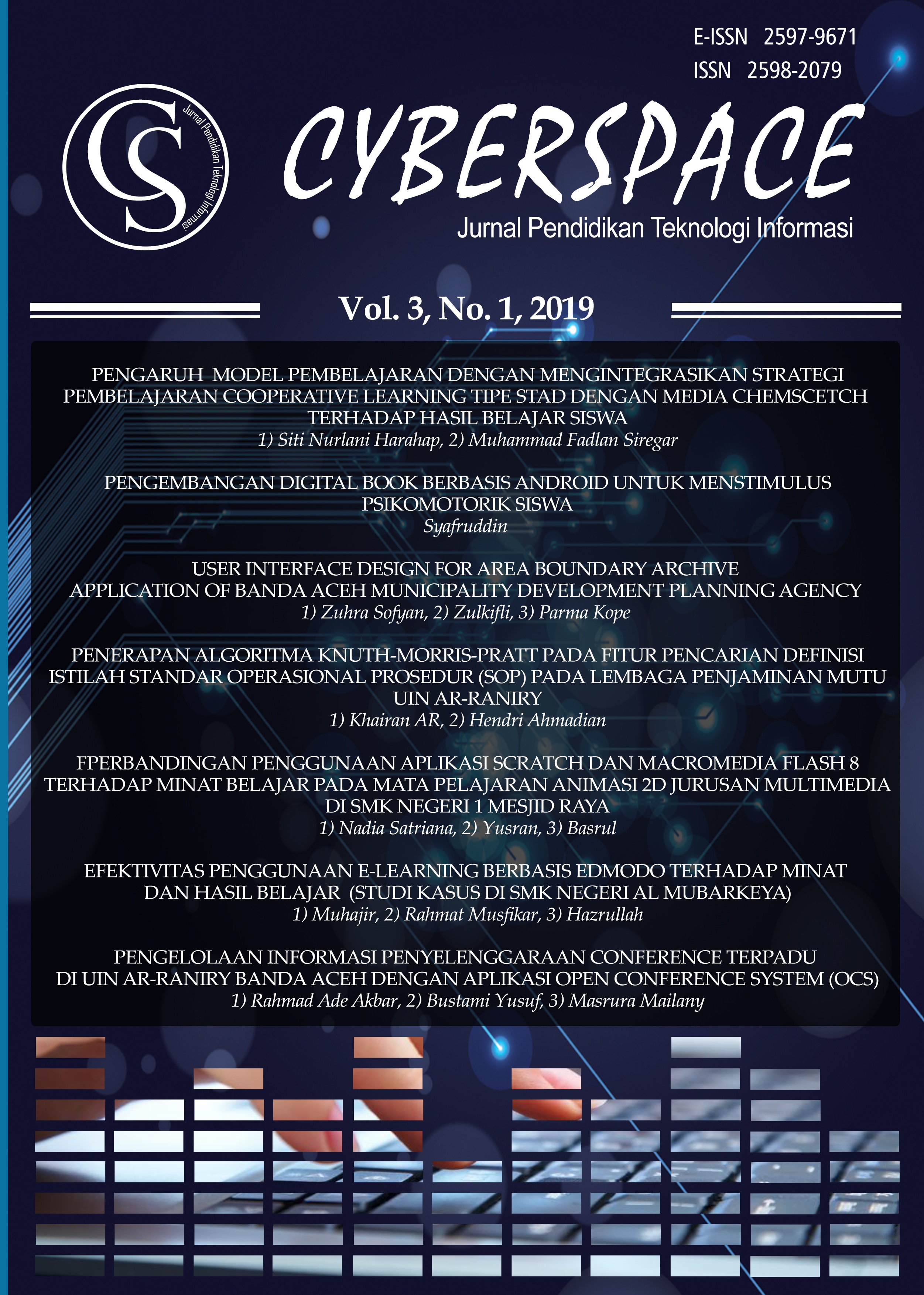USER INTERFACE DESIGN FOR AREA BOUNDARY ARCHIVE APPLICATION OF BANDA ACEH MUNICIPALITY DEVELOPMENT PLANNING AGENCY
DOI:
https://doi.org/10.22373/cj.v3i1.4673Keywords:
Area boundary document, Banda Aceh Municipality, DIA Cycle, User Interface, Archive information systemAbstract
This study aims to help the Development Planning Agency of Banda Aceh municipality in developing an online system interface for the data catalog of city boundary records. In addition, this research also aims to find out what functional requirements are needed by the user so the interface design will be able to assist people to store and retrieve the desired data. By using the DIA Cycle method, the interface design able to accommodate the user needs in utilizing the Banda Aceh city boundary catalog data archive system.References
B. K. B. Aceh, “Tupoksi Bappeda Kota Banda Aceh.” [Online]. Available: https://bappeda.bandaacehkota.go.id/profil/tupoksi/. [Accessed: 28-Apr-2019].
H. Risman, “Upaya Pemerintah Daerah Kabupaten Kutai Barat dalam Menyelesaikan Konflik Tapal Batas Antar Kampung di Daerah Kabupaten Kutai Barat,” Artik. dalam eJurnal Pemerintah. Integr., no. 3, 2015.
S. Ningsih and S. Asri, “Resolusi Konflik Tapal Batas Kabupaten Rokan Hulu Dan Kabupaten Kampar, Propinsi Riau,” J. Ilmu Sos. Mamangan, vol. 5, no. 2, pp. 60–68, 2017.
N. Kristiyono, “Konflik dalam Penegasan Batas Daerah antara Kota Magelang dengan Kabupaten Magelang (Analisis Terhadap Faktor-faktor Penyebab dan Dampaknya),” program Pascasarjana Universitas Diponegoro, 2008.
B. K. B. Aceh, “Pemutakhiran Peta Wilayah Administrasi Kota Banda Aceh,” 2018. [Online]. Available: https://bappeda.bandaacehkota.go.id/pemutakhiran-peta-wilayah-administrasi-kota-banda-aceh/. [Accessed: 24-Apr-2019].
C. R. McClure, “Technology in government document collections: Current status, impacts, and prospects,” Gov. Publ. Rev., vol. 9, no. 4, pp. 255–276, 1982.
M. Lowman, A Practical Guide to Analytics for Governments: Using Big Data for Good. Wiley, 2017.
S. Espley, F. Carpentier, R. Pop, and L. Medjkoune, “Collect, preserve, access: Applying the governing principles of the National Archives UK Government Web Archive to social media content,” Alexandria, vol. 25, no. 1–2, pp. 31–50, 2014.
M. Ngoepe, “Accountability, transparency and good governance: The National Archives and Records Service of South Africa’s role in helping government to better service delivery to the South Africans,” in Liasa’s 7th Annual Conference in Polokwane, South Africa, 2004, vol. 27.
I. K. Sardiana and I. W. P. Windia, “Pemetaan Partisipatif melalui Aplikasi GPS untuk Mitigasi Kon ik Batas Wilayah: Studi Kasus di Desa Adat Nyuh Kuning, Ubud, Bali,” J. Kaji. Bali (Journal Bali Stud., vol. 8, no. 1, pp. 145–158.
A. Tat-Kei Ho, “Reinventing local governments and the e-government initiative,” Public Adm. Rev., vol. 62, no. 4, pp. 434–444, 2002.
I. Sommerville, “Software process models,” ACM Comput. Surv., vol. 28, no. 1, pp. 269–271, 1996.
Z. Sofyan, “Learning Analytics in CourseMapper,” RWTH Aachen, 2016.
Downloads
Published
Issue
Section
License
Authors who publish with Cyberspace Journal agree to the following terms:
- Authors retain copyright and grant the journal right of first publication with the work simultaneously licensed under a Creative Commons Attribution License that allows others to share the work with an acknowledgement of the work's authorship and initial publication in this journal.
- Authors are able to enter into separate, additional contractual arrangements for the non-exclusive distribution of the journal's published version of the work (e.g., post it to an institutional repository or publish it in a book), with an acknowledgement of its initial publication in this journal.
- Authors are permitted and encouraged to post their work online (e.g., in institutional repositories or on their website) prior to and during the submission process, as it can lead to productive exchanges, as well as earlier and greater citation of published work (See The Effect of Open Access).



















